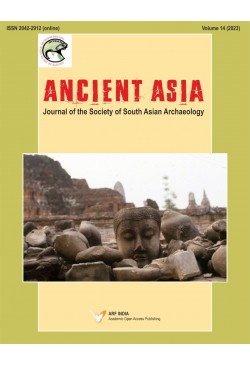AAAncient Asia

Peer Reviewed Journal

Peer Reviewed Journal
Depiction of Pregnancy and Child Birth in Early Indian Rock Art: An Overview of Socio-Cultural Behaviour
Rock art is an expression of human behaviour in a symbolic way. It is an assemblage of signs and symbols which are not easy to explain as they appear. Some of the symbols are very common worldwide like the symbols of procreation or fertility. These are present in art from palaeolithic art to modern art. Present research paper is a small attempt to highlight and decode these depictions like pregnancy, child birth and other scenes and symbols related to the theme in light of human’s biological, social and cultural behaviour. All kind of behaviour which are liable to bring individuals together, comes under social behaviour. Social behaviour is interaction of people to make the survival easy, it also includes cultural activities which can be seen as psychological support for survival. Reproduction is a part of human’s biological behaviour but it also builds social behaviour among people. Different steps of this process (reproduction) need social cooperation and psychological support which creates the basic structure of the society. In the present paper, through the study of rock art we will try to find out how the social and cultural behaviour of people in the past managed the evolutionary or biological problems of reproduction.
Keywords: rock art, pregnancy, child birth, evolution, obstetrics dilemma, human behaviour
Neelam Singh and Sachin Kumar Tiwary (2025). Depiction of Pregnancy and Child Birth in Early Indian Rock Art: An Overview of Socio-Cultural Behaviour. Ancient Asia, 16: 1, pp. 1-13. https://doi.org/10.47509/AA.2025.v16i01.1
“Timeless Wisdom of Yoga: Bridging Philosophy, Science, and Liberation”
This research paper explores Yoga as a holistic system that unites philosophy, science, and liberation (mok?a). By analyzing foundational texts such as the ?gveda, Ka?hopani?ad, Yoga V?si??ha, Ha?ha Yoga Prad?pik?, ?iva Sa?hit?, and the P?tañjala Yoga S?tras, the study traces Yoga’s historical evolution, etymology, and its role as a comprehensive epistemological system. Examining the Bhagavad G?t? and P?tañjala Yoga S?tras, the research highlights Yoga’s integrative worldview, harmonizing metaphysics, ethics, and self-realization. It also explores its scientific dimension through Samyama (Dh?ra??, Dhy?na, and Sam?dhi), demonstrating its structured approach to acquiring knowledge beyond sensory perception and logical inference. Employing a qualitative, interpretive methodology—incorporating hermeneutical analysis and textual exegesis—the study illustrates how Yoga bridges existence’s gross (Apara) and subtle (Para) dimensions, offering a holistic understanding of reality. Beyond its contemporary portrayal as a tool for health and well-being, Yoga emerges as both a timeless philosophy and a scientific discipline. Integrating philosophical inquiry, scientific exploration, and spiritual discipline serves as a transformative path to self-realization and universal harmony. This paper ultimately positions Yoga as an enduring heritage of wisdom that provides a comprehensive framework for understanding existence and attaining life’s ultimate truths.
Keywords: Yoga Philosophy, Yogic Epistemology, Gyan and Vigyan, Samyama and Knowledge Acquisition, Union and Dissolution in Yoga, S?dhana and S?dhya, P?tañjala Yoga S?tras, Bhagavad G?t? and Yoga, Spiritual Liberation (Mok?a), Apara and Para Prak?ti, Timeless Heritage of Yoga, Pancha Kosha and Consciousness, ?tambhar? Prajñ?, Indian Knowledge Systems, Philosophy and Science Integration, Historical Evolution of Yoga.
Ar. Sangita (Singhal) Agrawal & Dr. C. Nagraj (2025). “Timeless Wisdom of Yoga: Bridging Philosophy, Science, and Liberation”. Ancient Asia, 16: 1, pp. 15-28. https://doi.org/10.47509/AA.2025.v16i01.2
A Report on New Petroglyphs from Lianpui Village, Champhai District, Mizoram
Art is critical and essential for expressions that have been reflected on various materials throughout human history. Petroglyphs forming an important aspect of rock art is critical in understanding and reconstructing Mizoram’s history from an archaeological perspective. Art and its various forms of expressions have been extensively made on megaliths and this is further added by petroglyphs found on natural rock surfaces. Lianpui with its numerous megalithic engravings as well as petroglyphs, location on the peripheral area with instances of migrations in the past shows archaeological richness and potential. Interpretation and understanding of the archaeological materials would contribute towards the progress and development of archaeology and enrich the cultural heritage of Mizoram.
Keywords: Art. Petroglyphs. Mizoram. Lianpui
Lalhminghlua, Vanlalhuma Singson & C. Lalrinkima (2025). A Report on New Petroglyphs from Lianpui Village, Champhai District, Mizoram Ancient Asia, 16: 1, pp. 29-38. https://doi.org/10.47509/AA.2025.v16i01.3
Strontium Isotope Analysis of 4th Century Horse-tooth Fragments Recovered from a Daeseong-dong Royal Tomb of the Gaya Confederation
During the late 4th century CE, the situation on the Korean Peninsula was in a state of flux. Cavalry tactics in warfare, for example, were being actively adopted, and the horse-riding tradition was transmitted to Japan, along with other aspects of culture and practice. Two horse-tooth fragments found in a Daeseong-dong tomb dating to the 4th century Gaya Confederacy, therefore, can be of great significance to animal archaeology. In gross- orphological and ancient DNA (aDNA) analyses, we confirmed that the fragments from Tomb #1 were from horse teeth. To determine the breeding pattern for horses in the 4th century Gaya Confederacy, we subjected the fragments to strontium isotope (87Sr/86Sr) analysis. The 87Sr/86Sr values were 0.710083±0.000018 (KH-30) and 0.710263±0.000018 (KH-34), respectively, which were found to be mostly in close agreement with the herbaceous plant 87Sr/86Sr values representative of the southeastern part of the Korean Peninsula where the Gaya Confederacy and, later, the Silla Kingdom gained the ascendancy. We speculate that it was probably only after Korea was unified under the Silla Kingdom that horse breeding was established throughout the Peninsula by the central government.
Keywords: Daeseong-dong; Gaya; Horse; Isotope; Korea; Strontium
Jong Ha Hong, Young Min Ko & et al. (2025). Strontium Isotope Analysis of 4th Century Horse-tooth Fragments Recovered from a Daeseong-dong Royal Tomb of the Gaya Confederation. Ancient Asia, 16: 1, pp. 39-48. https://doi.org/10.47509/AA.2025.v16i01.4